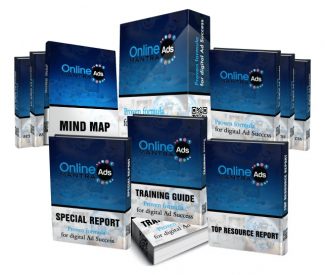 License Type: Personal Use
License Type: Personal Use  File Type: ZIP
File Type: ZIP
 SKU: 59812
SKU: 59812  Shipping: Online Download
Shipping: Online Download
Ebook Sample Content Preview:
Introduction
You’ve probably come across the term “online advertising” before in some form or another. It’s sometimes referred to as Search Engine Marketing (SEM), paid channel marketing, or pay-per-click (PPC) marketing. The terms are often used interchangeably to describe what essentially the same concept – purchased or “rented” traffic through online ads.
Most companies now realize that the best way to attract customers is to advertise online, and this is because most people turn to the Internet to find what they are looking for as mentioned above. Advertising online is now the most effective way to bring in target customers and increase sales. There are many ways in which a business or company can advertise online. This guide will outline the different ways that products, services and websites can be marketed and promoted on the web/ social media. Increasing mobile network and affordability of Internet has led to a healthy growth of online video advertising in 2016. The online video advertising industry had a very impressive 2016 with growth of 200%. The increase in consumption of video content enabled a shift in gears and growing demand. The accelerating rollout of mobile network and easy availability of affordable Internet access, suggest that 2017 will be the 'Year for Online Video Advertising’.
So make the most of it in 2017 to launch your business to the next level by using the amazing tips and techniques of online advertising on social media outlined in the chapters below.
Chapter 1
Online Ads: An
Overview
Online ads have become a daily part of internet life. For new marketers, it can be confusing getting a grasp on the scope and variety of online ads available.
Reasons You Should Be Advertising Online
If you’ve been slow on the uptake when it comes to online advertising, you should begin ramping up your efforts. Online ad spend has seen consistent growth and is projected to overtake print, states a recent IAB report. If you haven’t yet familiarized yourself with online advertising, it’s time to do so. If you’re of the belief that advertising online is wasting your ad budget, think again. These are 9 reasons you should be advertising online:
1. Insight
Know exactly which ads brought in the highest number of qualifying leads. Know how many impressions were served, where they were served, and when. Identify your optimal channels, ad copy, and ad locations. The metrics and analytics available with online advertising allow you to see the exact cost of acquiring and converting a customer.
2. Targeting
Do you know the profile of your perfect customer? Online advertising gives you the ability to target and retarget the ideal prospects. Retargeting will serve ads based on prior engagement, enabling you to identify your ideal customer profile. Once you know what your customers look like, you will know just who to target and where to find all similar users online, making sure they too are being served your ads.
3. Creative
Your ability to target goes beyond reaching the right customers. You can take this one step further and serve the creative that will best resonate with each target. Using flash and in-banner video ads can increase brand recognition and highlight your competitive edge. A well-designed banner ad can turn your digital campaign from good to great.
4. Brand Awareness
Online advertising can be used to drive traffic to your site and build brand awareness. Effectively targeted campaigns can create brand influencers and reach complementary audiences. Use the endless online display space to be creative with rich media, establish your online presence, make an emotional connection, and get online consumers excited about who you are and what you have to offer.
5. Flexibility
Online advertising campaigns can be adjusted with a few clicks or keystrokes. You have the flexibility to respond to incoming data and make changes instantly. Similarly, you have the ability to pause campaigns or adjust your strategy in minutes. This flexibility allows you to stay in front of your customers– anticipate customer needs and adjust your ads before anyone even notices.
6. Scale
Many digital marketers are turning to self-service providers to manage their campaigns– create your own ads, choose your spend, scale and optimize across your networks as you see fit. You can also use a full-service provider who will optimize, scale, and spend accordingly, but this often comes with a monthly minimum. Whichever service you choose, scaling your campaign has never been easier.
Click Here To Download Online Ads Mantra Video Training
7. Cost
Digital channels are highly cost effective for marketers. Rates are typically set through a combination of ad size, ad location, performance, and demand. Considering the reach allotted via digital channels, moving your campaigns online is often much cheaper than more traditional offline channels like radio, television, or print.
8. Reach
We’ve heard a lot of this lately — people are watching less live TV and turning to their computers for their favorite shows, music, and to access their news. As marketers, being effective requires staying in front of your customers; as it turns out, your customers are online, so you should be too, and sooner rather than later! Moving online gives you access to a global audience, if you so desire, and it means your ads can be working for you 24 hours a day. The options are practically limitless when it comes to your reach capabilities when you take your campaign online.
9. Engagement
Online advertising lets you know a customer’s exact level of engagement. You might have circulation and readership data for a print publication, but you can’t know how much time customers spent interacting with your ad, how much time they spent on your website, if they researched more of your products, and whether that ad led to conversions. An online presence gives you all of this valuable data and places you in a position to learn where your most engaged prospects live.
Types of Ads
Findbelow a thorough list to help categorize and explain each form of online ads present on the web.
1. Google Search Ads
Google search ads are online ads that appear alongside the search engine result page when users search a keyword query on Google. These ads are PPC, or pay-per-click ads, in which advertisers pay for each ad click. Google’s PPC search ads are managed by Google’s AdWords advertising platform, which allows advertisers to bid on keywords, craft ad text, set budgets, and more. To advertise on Google AdWords, you'll need to create a Google AdWords Account.
2. AdWords Ads
AdWords ads are online advertisements created within Google’s AdWords advertising platform, identical to Google search ads.
3. PPC Ads
PPC ads, AKA Pay-per-click ads, are advertisements in which the cost of advertising is determined by the number of clicks an ad receives. AdWords and Bing Ads both use a pay-per-click model.
4. Bing Ads
Bing Ads are similar to Google Ads in that they work on a pay-per-click basis. Advertisers can manage their Ads through the Bing Ads service, formerly known as Microsoft AdCenter. You can get started with creating Bing Ads here once you have a Bing Ads Account.
5. Facebook Ads
Facebook ads exist in many different forms, each offering unique pros and cons for advertisers looking to market on Facebook. Marketplace ads appear in the side columns of the Facebook website with a headline, copy, and an image.
Promoted Posts are Facebook ads that let advertisers pay a flat rate to promote a single post on their Facebook business page. The promoted post reaches more fans and friends of fans than a regular post.
Sponsored Stories show a user’s interaction with an advertiser’s page or product to the user’s friends and larger network. Sponsored Stories are also one form of Facebook ads that can appear in a user’s newsfeed.
FBX, or Facebook Exchange, are Facebook ads that implement remarketing. These ads take into account a user’s web surfing history data, letting an advertiser show an ad for a product a user was looking at earlier on the advertiser’s website.
6. Twitter Ads
Twitter ads refer to the paid boosts that brands on Twitter can use to extend the reach of their tweets, promote a chosen hashtag, or gain more followers.
Promoted Tweets lets advertisers’ tweets reach more people’s home feeds, and offer a healthy batch of targeting options. Twitter ads also include Promoted Accounts, letting advertisers show up more often in Twitter’s Who to Follow recommendation feature. Promoted Trends gets your custom hashtag in the Trends bar, earning additional attention and notice from the Twitterverse.
- License: Personal Use
- Category:Ebooks
- Tags:2017 Ebooks Personal Use








